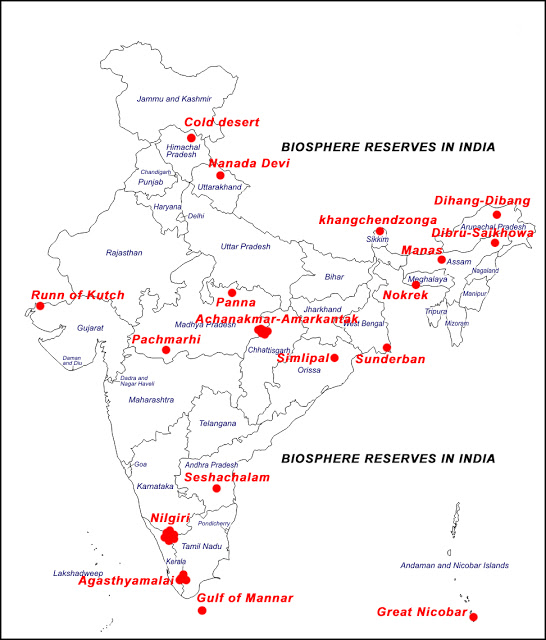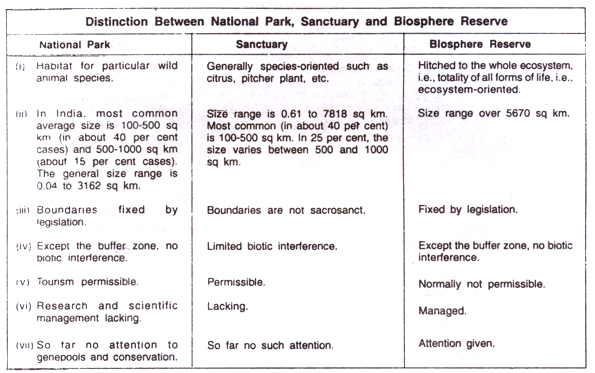Prelims Spotlight is a part of “Nikaalo Prelims 2020” module. This open crash course for Prelims 2020 has a private telegram group where PDFs and DDS (Daily Doubt Sessions) are being held. Please click here to register.
National Parks, Biosphere Reserves, Wildlife Sanctuaries in India – Part 2
22 April 2020
India is one of the 17 megadiverse countries of the world. With only 2.4% of the world’s land area, 16.7% of the world’s human population and 18% livestock, it contributes about 8% of the known global biodiversity, however, putting enormous demands on our natural resources. India is home to world’s largest wild tigers population and has a unique assemblage of globally important endangered species like Asiatic lion, Asian Elephant, One-horned Rhinoceros, Gangetic River Dolphin, Snow Leopard, Kashmir Stag, Dugong, Gharial, Great Indian Bustard, Lion Tailed Macaque etc. The following steps have thus been taken to protect and manage the wildlife of the country:
Conservation of Wildlife:
1. The Government of India enacted the Wild Life (Protection) Act 1972 with the objective of effectively protecting the wildlife of this country and to control poaching, smuggling and illegal trade in wildlife and its derivatives.
- The act extends to the whole of India except J&K which has its own wildlife act.
- It has 6 schedules which give varying degrees of protection.
- Schedule I and part II of Schedule II provide absolute protection and offences under these are prescribed the highest penalties.
- The penalties for Schedule III and Schedule IV are less and these animals are protected.
- Schedule V includes the animals which may be hunted. These are the Common crow, Fruit bats, Mice & Rats only.
- Schedule VI contains the plants, which are prohibited from cultivation and planting.
2. A National Board for Wildlife (NBWL), chaired by the Prime Minister of India provides for a policy framework for wildlife conservation in the country.
3. The National Wildlife Action Plan (2002-2016) was adopted in 2002, emphasizing the people’s participation and their support for wildlife conservation. The Draft National Wildlife Action Plan (NWAP) 2017-31 envisages 17 focus areas, including a new area linking wildlife planning to climate change.
4. The Indian Constitution entails the subject of forests and wildlife in the Concurrent list thus laying the responsibility of wildlife conservation on both the Centre and the State. The Federal Ministry acts as a guiding torch dealing with the policies and planning on wildlife conservation, while the provincial Forest Departments are vested with the responsibility of implementation of national policies and plans.
5. Specialized projects: To save the endangered species of animals, specialised projects are being implemented with international cooperation (WWF, UNDP, UNEP, IUCN) as well as on a stand-alone basis e.g.
- Project Tiger 1973
- Operation Crocodile 1975
- Project Rhinoceros 1987
- Project Snow Leopard
- Project Elephant 1988
More recently, the Black Buck (chinkara), the Great Indian Bustard (godawan) and the snow leopard etc. have been given full or partial legal protection against hunting and trade throughout India.
6. The Protected Areas of India:
Protected areas are those in which human occupation or at least the exploitation of resources is limited. These are defined according to the categorization guidelines for protected areas by the International Union for Conservation of Nature (IUCN). There are several kinds of protected areas, which vary by level of protection depending on the enabling laws of each country or the regulations of the international organizations involved.
There are 4 categories of the Protected Areas in India viz,
- National Parks,
- Sanctuaries,
- Conservation Reserves, and
- Community Reserves.

Let’s look at these in detail:
- National Park:
- A National park is an area with enough ecological, geo-morphological and natural significance with rich fauna and flora, which is designed to protect and to develop wildlife or its environment.
- National parks in India are IUCN category II protected areas.
- Activities like grazing, hunting, forestry or cultivation etc. are strictly prohibited. No human activity is permitted inside the national park except for the ones permitted by the Chief Wildlife Warden of the state.
- India’s first national park was established in 1936 as Hailey National Park, now known as Jim Corbett National Park, Uttarakhand.
- There are 104 existing national parks in India covering an area of 40501.13 km2, which is 1.23% of the geographical area of the country (National Wildlife Database, May 2019).
- Wildlife Sanctuary:
- Any area other than area comprised with any reserve forest or the territorial waters can be notified by the State Government to constitute as a sanctuary if such area is of adequate ecological, faunal, floral, geomorphological, natural. or zoological significance, for the purpose of protecting, propagating or developing wildlife or its environment.
- The difference between a Sanctuary and a National Park mainly lies in the vesting of rights of people living inside. Unlike a Sanctuary, where certain rights can be allowed, in a National Park, no rights are allowed. No grazing of any livestock is permitted inside a National Park while in a Sanctuary, the Chief Wildlife Warden may regulate, control or prohibit it.
- There are a total of 551 wildlife sanctuaries in India.
- Conservation reserves and community reserves in India:
- These terms denote the protected areas of India which typically act as buffer zones to or connectors and migration corridors between established national parks, wildlife sanctuaries and reserved and protected forests of India.
- Such areas are designated as Conservation Reserves if they are uninhabited and completely owned by the Government of India but used for subsistence by communities and Community Reserves if a part of the lands is privately owned.
- These protected area categories were first introduced in the Wildlife (Protection) Amendment Act of 2002 − the amendment to the Wildlife Protection Act of 1972.
- These categories were added because of reduced protection in and around existing or proposed protected areas due to private ownership of land, and land use.
7. Biosphere Reserves: A biosphere reserve is an area of land or water that is protected by law in order to support the conservation of ecosystems, as well as the sustainability of mankind’s impact on the environment.
- Each reserve aims to help scientists and the environmental community figure out how to protect the world’s plant and animal species while dealing with a growing population and its resource needs.
- To carry out the complementary activities of biodiversity conservation and sustainable use of natural resources, biosphere reserves are traditionally organized into 3 interrelated zones, known as:
- the core area,
- the buffer zone, and
- a transition zone or ‘area of cooperation.

- The purpose of the formation of the biosphere reserve is to conserve in situ all forms of life, along with its support system, in its totality, so that it could serve as a referral system for monitoring and evaluating changes in natural ecosystems.
- Presently, there are 18 notified biosphere reserves in India. Ten out of the eighteen biosphere reserves are a part of the World Network of Biosphere Reserves, based on the UNESCO Man and the Biosphere (MAB) Programme list.

Click here for the list of National Parks/Wild Life Sanctuaries and Biosphere Reserves
How is a biosphere reserve different from a national park/ wildlife sanctuary?
Biosphere Reserves of India protect larger areas of natural habitat (than a National Park or Wildlife Sanctuary). Biosphere Reserves may cover multiple National Parks, Sanctuaries and reserves as well.
Ex. the Nilgiri Biosphere covers: Bandipur National park, Mudumalai Tiger Reserve, Silent Valley National Park, Nagarhole National Park, Mukurthi National Park and is usually a contiguous area.
Some of the other differences are listed in the image below:

8. Some other important Conservation Sites:
- Tiger reserves – Project Tiger was launched by the Government of India in the year 1973 to save the endangered species of tiger in the country. Starting from nine (9) reserves in 1973 the number has now grown up to fifty (50) in 2016.
- Elephant reserves
- RAMSAR Wetland Sites [Related Reading: Everything that you need to know about Wetlands, A complete list of RAMSAR wetland sites in India can be found here]
- UNESCO World Heritage Sites (Natural, Cultural and Mixed) – Places listed by the United Nations Educational, Scientific and Cultural Organization as of special cultural or physical significance.
- Marine Protected Areas
- Important Bird Areas
9. Role of communities: Communities have played a vital role in the conservation and protection of wildlife in India. E.g.
- Sariska Tiger Reserve: In Sariska tiger reserve Rajasthan villagers have fought against mining by citing the wildlife protection act. In many areas, villagers themselves are protecting habitats and explicitly rejecting government involvement.
- Bhairodev Dakav Sonchuri: The inhabitants of five villages in the Alwar district of Rajasthan have declared 1200 hectares of forests as the Bhairodev Dakav Sonchuri declaring their own set of rules and regulation which do not allow hunting, and are protecting the wildlife against any outside encroachments.
- Bishnoi villages: In and around Bishnoi villages in Rajasthan, herds of blackbuck, Nilgai and peacocks can be seen as an integral part of the community and nobody harms them.

